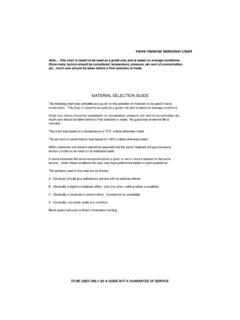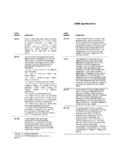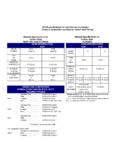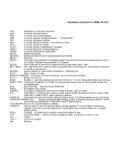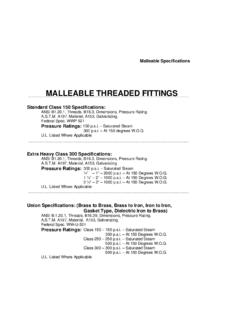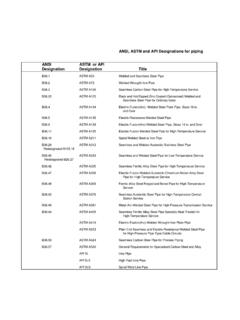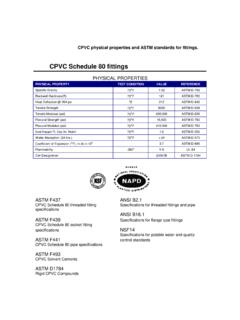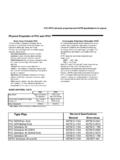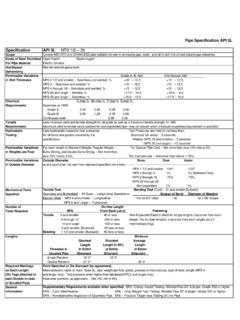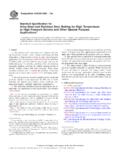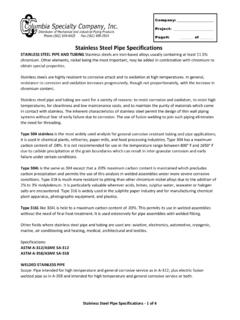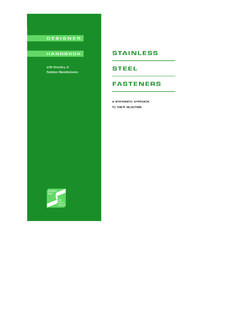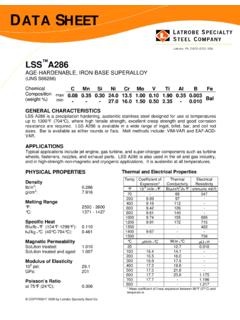Transcription of STAINLESS STEEL PIPE AND TUBING
1 STAINLESS STEEL pipe specifications STAINLESS STEEL pipe AND TUBING STAINLESS steels are iron-based alloys usually containing at least chromium. Other elements , nickeI being the most Important, may be added in combination with chromium to obtain special properties. STAINLESS steels are hi ghly resistant to corrosive attack and to oxidation at high temperatures. in general, resistance to corrosion and oxidation increases progressively, though not proportionately, with the increase in chromium content.
2 STAINLESS STEEL pipe and TUBING are used for a variety of reasons: to resist corrosion and oxidation, to resist high temperatures, for cleanliness and low maintenance costs, and to maintain the purity of materials which come In contact with STAINLESS . The inherent characteristics of STAINLESS st eel permits the design of thin wall piping systems without fear of early failure due to corrosion. The use of fusion welding to join such piping eliminates the need for threading. Type 304 STAINLESS is the most widely used analysis for general corrosive resistant TUBING and pipe applications, it is used in chemical plants, refineries, paper mills, and food processing industries.
3 Type 304 has a maximum carbon content of .08%. It is not recommended for use in the temperature range between 800 F and 1650 F due to carbide precipitation at the grain boundaries which can result in inter-granular corrosion and early failure under certain conditions. Type 304L. Is the same as 304 except that a .03% maximum carbon content is maintained which precludes carbon precipitation and permits the us e of this analysis in welded assemblies under more severe corrosive conditions. Type 318 is much more resistant to pitting than other chromium nickel alloys due to the addition of 2% to 3% molybdenum.
4 It is particularly valuable wherever acids, brines, sulphur water, seawater or halogen salts are encountered. Type 316 is widely used in the sulphite paper industry and for manufacturing chemical plant apparatus, photographic equipment, and plastics. Type 316L, like 304L, is held to a maximum carbon content of .03%. This permits its use in welded assemblies without the need of final heat treatment. It is used extensively for pipe assemblies with welded Other fields where STAINLESS STEEL pipe and TUBING are used are: aviation, electronics, automotive, cyrogenic, marine, air conditioning and heating, medical, architectural and textiles.
5 Specifications: ASTM A-312/ASME SA-312 WELDED STAINLESS pipe ASTM A-358/ASME SA-358 Scope: pipe intended for high temperature and general corrosive service as in A-312, plus electric fusion welded pipe as in A-358 and intended for hi gh temperature and general corrosive service or both. General Requirements: Conforming to the above specifications plus applicable parts us ASTM A-530. Range: ASTM A-312 pipe is more commonly found from 1/8" IPS to and including 24 IPS in standard schedules 5, 10, 20, and 40. On special applications, sizes can be produced to 60 lPS through schedule 80 walls by certain mills.
6 ASTM A-358 is usually produced in sizes 8 IPS and larger and where filler metal is added to the weld. This specification covers five classes of pipe and are usually determined by the end application and needs of the pipe . ASTM A-312 pipe is manufactured by two different processes. pipe through 6 IPS is manufactured by the continuous welding process and is very similar to welded TUBING . Coils of flat roll strips are fed into sizing rolls and welded. Material is then annealed (usually in an open air furnace), straightened, cut, pickled, tested, and inspected.
7 In full finished pipe , material is cold worked after welding. This can be done by rolling, forgi ng, or drawing the weld bead; but primarily the weld is rolled. pipe 8 IPS and larger is manufactured by the batch method or process. Unlike the continuous welding method. material made by this batch method is made in single lengths. Plates, cut to length and width, are formed from flat into tubular shape by a press and welded. Material is then annealed, sized, and straightened, ends trimmed or cut to specific smaller lengths, pickled, and inspected. STAINLESS STEEL pipe specifications pipe and TUBING As-Welded Grade as-welded pipe and tub- ing is straight-seam welded using ASME qualified automatic gas tungsten-arc procedures and can be supplied in a wide range of diameters and wall thicknesses from any of the weldable corrosion resistant alloys.
8 Normally furnished with square cut ends, pipe with beveled, belied, or roil-grooved ends can be provided. Spot radiography or 100% radiography of welded seams can also be performed. Alaskan pickles and passivates its pipe and TUBING to maintain corrosion resistance and to prevent surface discoloration from free iron oxidation. As-welded pipe and TUBING is co mmonly used in pulp and paper mills, food processing plants. and other industries where corrosion resistance is essential. ASTM A 778 This specification covers welded unannealed STAINLESS STEEL pipe intended for lo w to moderate temperatures and corrosive service where heat treatment is not required fo r corrosion resistance.
9 A 788 is considered to be the most applicable ASTM specification for as welded pipe and differs from it only in that a transverse guided-be nd test and a transverse tension test are required per lot. ASTM A 213 (ASME SA-213 is identical) This specification includes minimum wall thickness seamless austenitic STAINLESS st eel TUBING intended for high temperature usage such as boiler, superheater and heat exchanger tubes, Production is generally limited to TUBING A inside diameter to 5 outside diameter and .015 to ,500 inclusive in wail thickness. All material is to be furnished in the heat treated condition. Alaskan stocks average wall austenitic A 213 TUBING .
10 ASTM A 249 (ASME SA-249 is generally identical) This specification covers welded austenitic STAINLESS STEEL TUBING intended for high temperature usage such as boiler, superheater, heat exchanger, or condenser tubes. Production is generally limited to TUBING 1/8" inside diameter through 5 outside diameter and .01 5 to .320 inclusive in wall thickness. All material is to be furnished in the heat treated condition. The principal manufacturing procedures specified under A 249 are: 1. Automatic welding process with no addition of filler metal. 2. Hydrostatic or non-destructive electric test of each tube. 3. Tension, flattening, flange.

